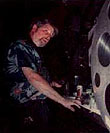|
|
This topic comprises 2 pages: 1 2
|
|
Author
|
Topic: Shutter Ghost Question
|
|
|
|
|
|
|
|
|
|
|
|
|
|
|
|
|
|
|
|
|
Paul G. Thompson
The Weenie Man

Posts: 4718
From: Mount Vernon WA USA
Registered: Nov 2000
|
 posted 02-04-2002 03:51 PM
posted 02-04-2002 03:51 PM




If there is an "outdoor" shutter on your machine, and it is timed correctly, you could have ghosting equally on the top and bottom of the picture. If so, switch to a 90 degree shutter and your problem will probably go away.If you have a pulsating ghose on the top or bottom, better check your gear train. I have seen this on occasion in Centrury and XL's several times. This problem can occur in a Brenkert if the shear key is on the verge of failing.
| IP: Logged
|
|
|
|
Frank Angel
Film God

Posts: 5305
From: Brooklyn NY USA
Registered: Dec 1999
|
 posted 02-05-2002 01:59 AM
posted 02-05-2002 01:59 AM





One of our Century's had a severe shutter problem with the concentric shaft oscillating toward and away from the rear shutter housing. The ghosting was all over, above AND below the credits, plus the speed of the machine became "variable," pulsing in time with the oscillation. Like Paul said, definately a gear-train problem, and wicked one at that. I tried to determine what the cause was, but there was nothing obvious that I could see without ripping the whole thing down. We sent it right back to the seller as it was a rebuilt and had been run less than four shows. The company never actually explained what was wrong, so I just assumed they'd rather not admit that they just left out a gear or two in their rebuiding process! eek! Anyone have the scoop on "drive-in" intermittents? My recollection is that their pull down was very fast, allowing the shutter to stay opened longer, letting more light thru. In the one DI that I worked I recall that they had cut-down shutters for the DI intermittent but when one died they replaced it with a standard and that caused plenty of ghosting. If I remember correctly, the DI intermittent sprocket seemed to be lighter with holes in the sides as opposed to solid like a normal drive sprocket. Question is, do these DI intermittents have any downsides? I remember they were really noisy. Any other disadvantages? Seems like if they had no ill side effects, they would be a cheaper alternative than installing a bigger lamphouse in a system that needed a brighter picture, although I would be really hesitant cutting down the shutters....like drilling that first hole in the roof when I installed the sun roof on my car.
| IP: Logged
|
|
Paul G. Thompson
The Weenie Man

Posts: 4718
From: Mount Vernon WA USA
Registered: Nov 2000
|
 posted 02-05-2002 02:17 AM
posted 02-05-2002 02:17 AM




Hi, FrankSimplex had a high-speed movement for the XL's, and they were quite scarce and expensive. And, wear some ear protectors if you are standing along side the machine....especially if they are worn out. A downside to them is your splices better be perfect. They will yank a splice apart of the splicing tape is a poor grade, or if you didn't clean the surface before applying the tape. Whether other manufacturers made them or not, I really don't know.... Paul
| IP: Logged
|
|
John Pytlak
Film God

Posts: 9987
From: Rochester, NY 14650-1922
Registered: Jan 2000
|
 posted 02-05-2002 08:07 AM
posted 02-05-2002 08:07 AM





The high speed "Drive-In" intermittents used an additional linkage to achieve a 5:1 pulldown (72-degrees) rather than the usual 4:1 pulldown (90-degrees) of a normal 4-slot starwheel. They were quite noisy, had additional components to wear, and the higher acceleration could stress perforations and splices.Kodak has just patented a modified 4-slot starwheel design that achieves the faster pulldown WITHOUT an additional linkage. Here is a link to the November 2001 SMPTE Journal paper "Design Improvements for Motion Picture Film Projectors" by DuMont, Kurtz, Silverstein, and Kirkpatrick. This paper describes improvements developed for motion picture film projectors, in particular, new designs for the intermittent, or Geneva mechanism, and for a Universal lamp house. These new designs are intended to improve the quality of the overall screen image as well as light efficiency and uniformity, resulting in significant increases in screen luminance:
http://www.electronicipc.com/JournalEZ/mo/detail.cfm?code=45390010011103 (for SMPTE on-line library subscribers) Here is a link to the Kodak patent (US Patent 6,183,087):
U.S. Patent 6,183,087 The new Kodak starwheel design can be retrofit to existing intermittents, greatly increasing the efficiency of illumination, in other words, putting more light on the screen!  ------------------
John P. Pytlak, Senior Technical Specialist
Worldwide Technical Services, Entertainment Imaging
Research Labs, Building 69, Room 7525A
Rochester, New York, 14650-1922 USA
Tel: 716-477-5325 Cell: 716-781-4036 Fax: 716-722-7243
E-Mail: john.pytlak@kodak.com
Web site: http://www.kodak.com/go/motion
| IP: Logged
|
|
|
|
All times are Central (GMT -6:00)
|
This topic comprises 2 pages: 1 2
|
Powered by Infopop Corporation
UBB.classicTM
6.3.1.2
The Film-Tech Forums are designed for various members related to the cinema industry to express their opinions, viewpoints and testimonials on various products, services and events based upon speculation, personal knowledge and factual information through use, therefore all views represented here allow no liability upon the publishers of this web site and the owners of said views assume no liability for any ill will resulting from these postings. The posts made here are for educational as well as entertainment purposes and as such anyone viewing this portion of the website must accept these views as statements of the author of that opinion
and agrees to release the authors from any and all liability.
|

 Home
Home
 Products
Products
 Store
Store
 Forum
Forum
 Warehouse
Warehouse
 Contact Us
Contact Us




 Printer-friendly view of this topic
Printer-friendly view of this topic




















